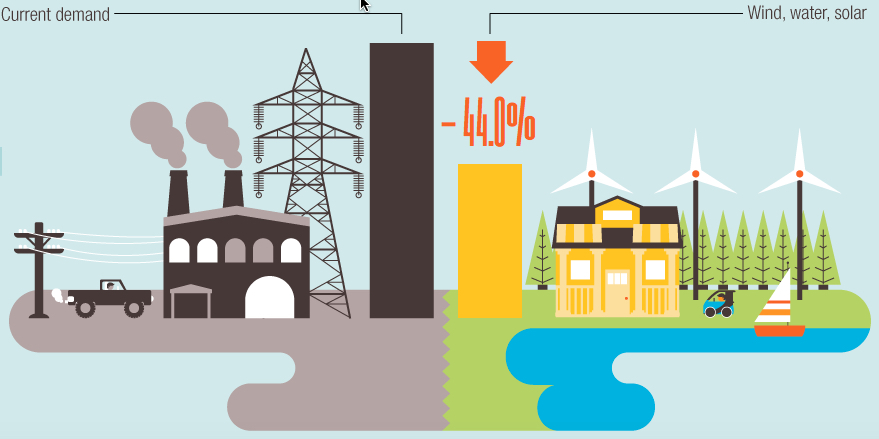Storing solar, wind, and water energy underground could replace burning fuel
November 23, 2015

Using wind, water, and solar electricity for everything, instead of burning fuel, with resulting improved energy efficiency, means you need much less energy (credit: The Solutions Project/data: Stanford University)
Stanford and UC Berkeley researchers have a solution to the problem of storing energy from wind, water and solar power overnight (or in inclement weather): store it underground. The system could result in a reliable, affordable national grid, replacing fossil fuel, they believe.
How it would work
- Summer heat gathered in rooftop solar collectors could be stored in soil or rocks and used for heating homes in winter. Excess or low-cost electricity could be used to make ice, which would be used for later cooling when the price of electricity is high.
- Excess electricity could also used to make more electricity, by supplementing the energy-producing mechanisms that drive concentrated solar power plants and pumped hydroelectric facilities. Utilities would also provide incentives to reduce energy use during times of peak demand.
- Hydrogen would also be used as a storage medium; during low-demand hours, excess electricity would be used to create hydrogen, which could be stored in fuel cells and used to power some vehicles.
- This would be an all-electric country, with virtually everything running 100 percent on electricity: cars, trains, buses, industry, heating and cooling, and with the electricity originating from wind, water and sunlight. There would be no need for coal, natural gas, biofuels, nuclear power or enormous battery farms for storing electricity. Such a world would be 100 percent clean by 2050.
This methodology for keeping the grid stable should work in many places worldwide, say Mark Z. Jacobson, a Stanford professor of civil and environmental engineering, Mark Delucchi of the University of California, Berkeley, and associates. They describe the plan today (Nov. 23) in Proceedings of the National Academy of Sciences.
According to the authors, in the U.S., for example, the resulting drop in air pollution would save tens of thousands of lives each year (up to 65,000 people die prematurely in America annually as a result of air pollution) and the plan could result in about 5 million 40-year jobs.
Abstract of A low-cost solution to the grid reliability problem with 100% penetration of intermittent wind, water, and solar for all purposes
This study addresses the greatest concern facing the large-scale integration of wind, water, and solar (WWS) into a power grid: the high cost of avoiding load loss caused by WWS variability and Q:10 uncertainty. It uses a new grid integration model and finds lowcost, no-load-loss, nonunique solutions to this problem on electrification of all US energy sectors (electricity, transportation, heating/cooling, and industry) while accounting for wind and solar time series data from a 3D global weather model that simulates extreme events and competition among wind turbines for available kinetic energy. Solutions are obtained by prioritizing storage for heat (in soil and water); cold (in ice and water); and electricity (in phase-change materials, pumped hydro, hydropower, and hydrogen), and using demand response. No natural gas, biofuels, or stationary batteries are needed. The resulting 2050–2055 US electricity social cost for a full systems is much less than for fossil fuels. These results hold for many conditions, suggesting that low-cost, stable 100% WWS systems should work many places worldwide.